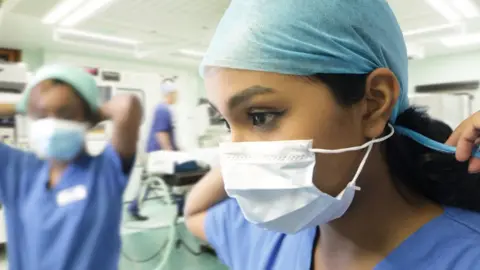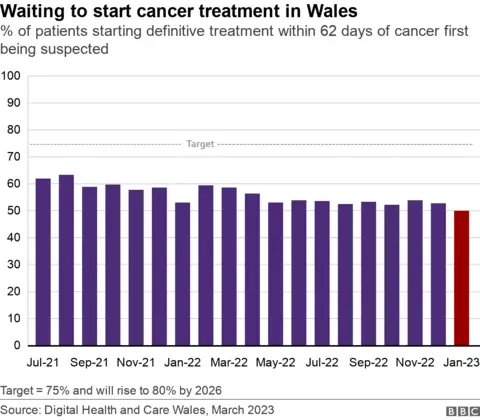NHS Wales waiting times: Worst cancer figures but progress elsewhere
 Getty Images
Getty ImagesWaiting times and ambulance response times are continuing to improve in Wales.
However, performance on the main cancer target was the worst on record.
A&E waiting times have bounced back from a record low in previous figures to the best performance in nearly two years.
The health minister said despite winter pressures, it was a picture of "progress being made and improvements in most areas".
Eluned Morgan however acknowledged that cancer performance was "still not where I expect it to be".
Although the proportion of patients starting treatment within 62 days of cancer first being suspected is the lowest on record, it "reflects our current focus on reducing the number of people that have already waited longer than 62 days for investigation or treatment," she added.
Ms Morgan said: "We are investing heavily in cancer services to improve early detection and provide rapid access to investigation, treatment and high quality care."
One leading cancer charity said Wales' cancer system was in crisis and was "consistently failing to keep up with a rising demand for cancer care".
The number of people waiting for hospital treatment, after referral, fell for a fourth month in a row.
There were still 734,116 "patient pathways" on the list - this is about 576,000 actual patients, when those who are on more than one waiting list are counted.
Those waiting more than a year or two years for treatment also continued to fall.
Those waiting more than a year fell by nearly 9,500 to 152,464 - the lowest number for two years.
There are still 41,103 patients waiting more than two years.
There are also still higher proportions of long waits compared to England, where just over 5% of patients are waiting more than a year, compared to 20.8% in Wales.
There are also hardly any patients waiting two years in England, while people waiting that long still make up 5.3% of the waiting list in Wales.
The key post-pandemic NHS Wales recovery target - that no-one should wait more than a year for an outpatient appointment - continues to be missed, although in-roads have been made on the list for a fifth month in a row.
There were still 67,615 patients waiting more than a year, a monthly drop of 7,358.
There was a second monthly improvement in ambulance response times, with 50.9% of immediately life-threatening "red" calls attended to within eight minutes in February, but still worse than 12 months earlier and below the 65% target for the 31st month in a row.
The average response time to "red" calls was seven minutes 54 seconds, which was faster than in January but 31 seconds slower than February 2022.
There was another fall in handover delays. There were 11,397 "lost" hours by ambulances spending time outside major A&E units, unable to drop off patients beyond the 15 minute target - the lowest figure since the summer of 2021.
Numbers stuck in hospital despite being well enough to be discharged are roughly the same as the previous month, with just under 1,000 patients waiting for a care package or support to be arranged.
A&E waiting times have bounced back from a record low two months before to the best performance in nearly two years.
Against the four-hour target, 71.6% of people were admitted, transferred or discharged within that time frame.
Meanwhile, 8,036 people spent 12 hours or more in A&E before being seen - no-one should wait that long under current targets - although this was the lowest monthly total since the summer of 2021.
The median waiting time was two hours and 37 minutes - two minutes slower than the previous month but closer to pre-pandemic waiting times.
When we look at major emergency units only, Wales is also performing better than A&E units in England for a sixth month in succession, with 62.6% of patients seen within four hours, compared to 56.8% in England.

However, cancer performance figures have had their worst month since the new target was introduced.
Only half of people started their first treatment in January within 62 days of cancer being first suspected.
That was as low as 38% in both the Cwm Taf Morgannwg and Hywel Dda health board areas.
It continues to be lower too for gynaecological and prostate and bladder cancers.
Richard Pugh, of Macmillan Cancer Support in Wales, said: "Cancer treatment in Wales now rests firmly on the flip of a coin - people with cancer face no better than 50-50 odds on whether they are treated on time, or whether they face the heartache of delays that may impact on the outcomes that can be achieved for them and their quality of life."


Today's figures show more people coming through the system for cancer care. Clinicians have talked for some time of capacity issues, so the fact fewer are starting treatment within two months perhaps shouldn't be a surprise - but dropping to just 50% (against the target of 75%) still makes for uncomfortable reading.
Elsewhere, the numbers waiting for planned care dropped marginally. But in emergency care, while A&Es showed waits were improving, and a slight improvement in ambulance response times, February was a month beset with ambulance strikes. This caused ripples as patients knew care would be disrupted.
The health minister has asked that NHS bosses put even greater focus on cancer diagnoses and treatment - ahead of a ministerial cancer summit next week.

What has been the response?
Conservative health spokesman Russell George called it "another set of dire figures" that showed little improvement.
"For there still to be tens of thousands of people in Wales waiting over two years for treatment is a damning indictment on the Labour government's inability to make a genuine difference to the lives of patients and medical staff," he added.
Plaid Cymru called for innovative thinking.
The party's health spokesman Rhun ap Iorwerth said: "The sheer volume of patients still waiting for treatment - waiting far beyond Welsh government's own target times - is a bitter reminder that our NHS remains broken.
"It's not just the long waiting times, there are serious issues when it comes to patients who are well enough to be discharged unable to access the social care packages they require."
The NHS Confederation, which represents Welsh health boards, said the NHS was still recovering from a tumultuous winter.
"Things are going in the right direction, but progress is undoubtedly slower than anyone would like," said a spokesman.

Cwm Taf Morgannwg health board - which is responsible for three general hospitals, Royal Glamorgan near Llantrisant, Prince Charles in Merthyr Tydfil and Princess of Wales in Bridgend - is still facing significant pressures.
Paul Mears, the board chief executive, said: "We are still seeing very high volumes of people coming through as emergency patients through our front door and we have a lot of people sat on waiting lists, waiting for treatment, who we need to get diagnosed and treated as quickly as possible.
"And that is against the backdrop of significant workforce pressures that we are dealing with - as many NHS organisations across the UK are dealing with."
The health board also currently has 300 nursing vacancies, "an enormous number" and other challenges in the medical workforce,
"Lots of our consultant vacancies are in specialties where, frankly, if you were a consultant you could stick a pin in the map and go to work in any hospital in the UK because everybody's looking for those people," said Mr Mears.
The health board is to build the first regional diagnostic and surgical hub near the Royal Glamorgan, which will help tackle both planned care waiting times, as well as lengthy cancer treatment times.
It will also serve patients in two neighbouring health board, with hopes it will become available over the next year.
"Sometimes these sorts of levels of challenge necessitate an innovative approach and a different way of trying to deal with it because just going round the same old loop all the time isn't probably going to solve this problem, given the scale of what we're dealing with at the moment," said Mr Mears.

Enter a postcode to find out what is happening in your area with A&E, ambulances and hospital waiting lists across the UK.
